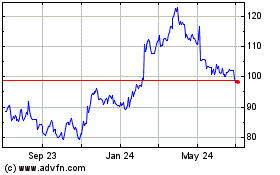By Benjamin Mullin
The handful of reporters moving near Orlando to cover the
restart of the National Basketball Association season will have to
make a few adjustments: eating all meals in their room the first
week, taking coronavirus tests daily and having to wear an
electric-fence-like tag keeping them away from one another.
The reporters are among many people whose health is key to the
resilience of the already abridged NBA season. Play could come to
an abrupt end if the virus were to make it inside the bubble that
the league has built at Walt Disney Co.'s ESPN Wide World of Sports
complex in an effort to insulate players, employees and media
outlets from the outside world.
Multiple parties, including some media outlets, have huge
financial stakes riding on the outcome. Due to the health risks,
and the costs of managing them, the NBA Playoffs will be covered by
fewer in-person reporters than usual, a person familiar with the
matter said.
About 15 news organizations have sent journalists to cover the
conclusion of the season in person, including ESPN, the Associated
Press and the Athletic, the person said. Traditionally, dozens of
media companies from around the world usually send staff to cover
the NBA Playoffs.
The NBA suspended its season in March when several of its
players contracted the virus. Play is set to resume Thursday.
If the league is forced to suspend play again, major TV networks
such as AT&T Inc.'s Turner Sports and Disney's ESPN could lose
hundreds of millions of dollars in TV ad revenue, according to
Michael Nathanson, an analyst at MoffettNathanson.
TV networks generated $972 million in advertising revenue during
last year's NBA playoffs, according to research firm Kantar, on top
of nearly $600 million in ad revenue from regular season NBA games.
ESPN and Turner Sports declined to comment.
Twenty-two of the NBA's 30 teams -- the ones that still have a
chance to make the playoffs -- will resume play inside Disney
World, and the league aims to crown a champion by October. The NBA
is spending more than $150 million to finish the season in Florida,
according to people familiar with the matter, who said the costs
include lodging for the teams, testing for the players and renting
arenas at the ESPN sports complex.
News organizations' costs to cover the event are also hefty:
more than $500 per reporter every day for housing, food, testing
and transportation, one of the people said, which could add up to
more than $50,000 per person for the duration of the season.
ESPN analyst Jeff Van Gundy said in an interview that the league
has done a good job to make the end of the season safe, but he
still has some concerns about the health of people inside the
bubble.
"Everybody's a little bit uneasy -- myself included -- about,
can we do this in a way that is healthy, both physically and
mentally?" Mr. Van Gundy said.
The NBA is taking unusual steps in an effort to limit the
chances of players getting infected. The league has asked
journalists not to approach players directly; instead, they have
been instructed to route their interview requests through
public-relations employees for various teams, who can coordinate
socially distant sit-downs.
Reporters and other attendees have also been asked to wear
credentials that sound an alarm when they stand too close to
another person for too long. And the post-practice presser
conducted over videoconference forces journalists to ask questions
in front of other beat reporters, making it difficult to chip away
at stories without alerting the competition.
Reporters who are on-site have some one-on-one access to players
and team officials, an NBA spokesman said, though those interviews
must be scheduled in advance.
Jalen Rose, co-host of "Jalen & Jacoby" and a contributor to
ESPN shows including "NBA Countdown," "First Take" and "Get Up,"
said in an interview that he is looking forward to covering the
tournament, adding that he would be at risk from catching the
coronavirus even if he weren't visiting Orlando.
"Do I have fear for my health?" Mr. Rose asked. "Yes, I do. But
you know how long I'm going to fear for it -- in particular with
the coronavirus? Until we get a vaccine."
Mr. Rose said ESPN has begun to make adjustments. The network is
beginning to use a larger desk that will allow analysts to stand at
least 6 feet apart while providing on-air commentary. ESPN is
limiting the number of people who can be in the makeup room. And
they're planning to conduct socially distant postgame
interviews.
Life at the media hotel can be monotonous. The press can fish in
a lake near the hotel, but some reporters said they are wary of
alligators and snakes there.
A major story line for the reporters in the bubble will be the
Black Lives Matter movement for racial justice, which has
galvanized many professional basketball players. That could be
tricky territory for ESPN, which under President Jimmy Pitaro has
sought to swerve away from pure commentary on politics.
The network plans to cover the effect of the movement on the
world of sports: Marc Spears, the senior NBA writer for ESPN's The
Undefeated website, is among the ESPN journalists planning to cover
stories related to the Black Lives Matter movement. The network
also plans to cover any pre-game protests that might arise,
according to a person familiar with the network's plans.
Write to Benjamin Mullin at Benjamin.Mullin@wsj.com
(END) Dow Jones Newswires
July 26, 2020 12:21 ET (16:21 GMT)
Copyright (c) 2020 Dow Jones & Company, Inc.
Walt Disney (NYSE:DIS)
Historical Stock Chart
From Aug 2024 to Sep 2024

Walt Disney (NYSE:DIS)
Historical Stock Chart
From Sep 2023 to Sep 2024
